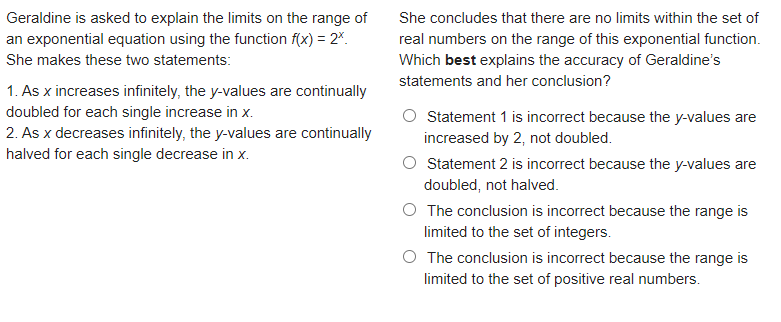Geraldine is asked to explain the limits on the range of an exponential equation using the function f(x) = 2*. She makes these two statements: 1. As x increases infinitely, the y-values are continually doubled for each single increase in x. 2. As x decreases infinitely, the y-values are continually halved for each single decrease in x. She concludes that there are no limits within the set of real numbers on the range of this exponential function. Which best explains the accuracy of Geraldine's statements and her conclusion? Statement 1 is incorrect because the y-values are increased by 2, not doubled. Statement 2 is incorrect because the y-values are doubled, not halved. The conclusion is incorrect because the range is limited to the set of integers. O The conclusion is incorrect because the range is limited to the set of positive real numbers.
Geraldine is asked to explain the limits on the range of an exponential equation using the function f(x) = 2*. She makes these two statements: 1. As x increases infinitely, the y-values are continually doubled for each single increase in x. 2. As x decreases infinitely, the y-values are continually halved for each single decrease in x. She concludes that there are no limits within the set of real numbers on the range of this exponential function. Which best explains the accuracy of Geraldine's statements and her conclusion? Statement 1 is incorrect because the y-values are increased by 2, not doubled. Statement 2 is incorrect because the y-values are doubled, not halved. The conclusion is incorrect because the range is limited to the set of integers. O The conclusion is incorrect because the range is limited to the set of positive real numbers.
Algebra & Trigonometry with Analytic Geometry
13th Edition
ISBN:9781133382119
Author:Swokowski
Publisher:Swokowski
Chapter5: Inverse, Exponential, And Logarithmic Functions
Section5.6: Exponential And Logarithmic Equations
Problem 64E
Related questions
Question
100%

Transcribed Image Text:Geraldine is asked to explain the limits on the range of
an exponential equation using the function f(x) = 2x.
She makes these two statements:
1. As x increases infinitely, the y-values are continually
doubled for each single increase in x.
2. As x decreases infinitely, the y-values are continually
halved for each single decrease in x.
She concludes that there are no limits within the set of
real numbers on the range of this exponential function.
Which best explains the accuracy of Geraldine's
statements and her conclusion?
Statement 1 is incorrect because the y-values are
increased by 2, not doubled.
Statement 2 is incorrect because the y-values are
doubled, not halved.
O The conclusion is incorrect because the range is
limited to the set of integers.
O The conclusion is incorrect because the range is
limited to the set of positive real numbers.
Expert Solution
This question has been solved!
Explore an expertly crafted, step-by-step solution for a thorough understanding of key concepts.
This is a popular solution!
Trending now
This is a popular solution!
Step by step
Solved in 2 steps with 2 images

Recommended textbooks for you

Algebra & Trigonometry with Analytic Geometry
Algebra
ISBN:
9781133382119
Author:
Swokowski
Publisher:
Cengage

Linear Algebra: A Modern Introduction
Algebra
ISBN:
9781285463247
Author:
David Poole
Publisher:
Cengage Learning


Algebra & Trigonometry with Analytic Geometry
Algebra
ISBN:
9781133382119
Author:
Swokowski
Publisher:
Cengage

Linear Algebra: A Modern Introduction
Algebra
ISBN:
9781285463247
Author:
David Poole
Publisher:
Cengage Learning


Intermediate Algebra
Algebra
ISBN:
9781285195728
Author:
Jerome E. Kaufmann, Karen L. Schwitters
Publisher:
Cengage Learning

College Algebra
Algebra
ISBN:
9781305115545
Author:
James Stewart, Lothar Redlin, Saleem Watson
Publisher:
Cengage Learning